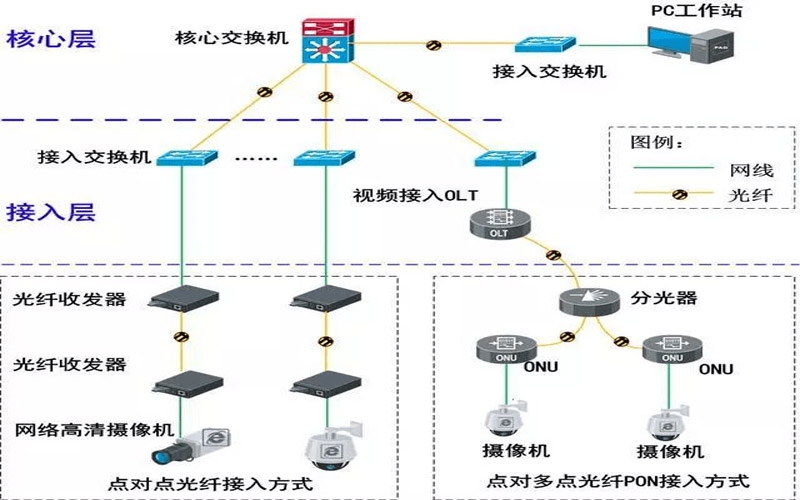Passive (PON) optical network application solution in weak current industry
With the development of video surveillance market and technology, network video surveillance technology has become the mainstream. In the network video surveillance transmission part, due to the maturity of PON technology and the flexible networking advantages of the PON system from point to multiple points, when building a video surveillance system, using PON technology to achieve front-end access to the video surveillance system becomes the best choice.
01
PON network requirements
Faced with the rapid growth of security services and the Internet of Things, as a large-bandwidth transmission method with low deployment costs and high flexibility, passive optical network PON has been increasingly deployed in transmission access networks around the world, and has the momentum to replace traditional switches access networking. Especially in scenarios such as road monitoring and safe cities with long coverage distances, PON is the most ideal and economical access method today.
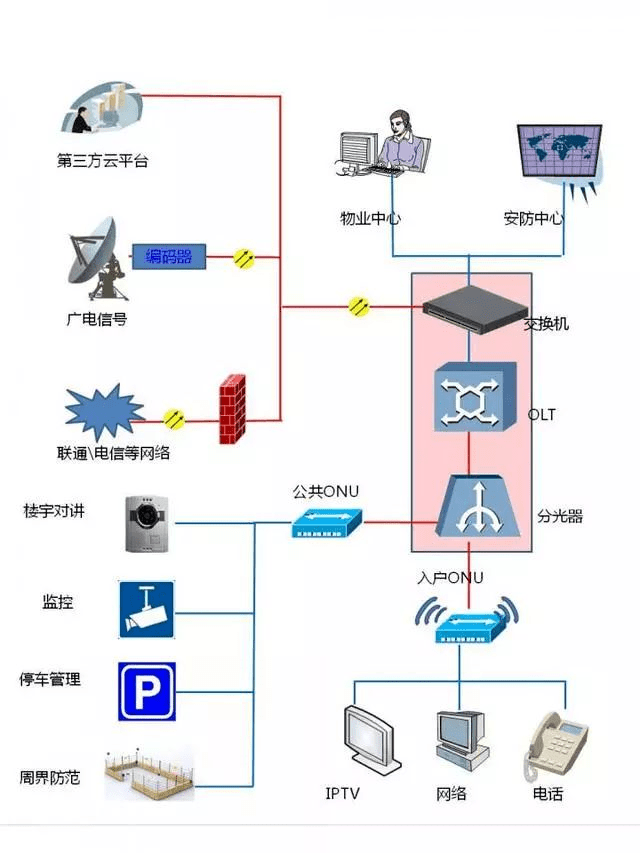
02
Monitoring network transmission design
The main role of the monitoring transmission network system is to access various monitoring resources, provide basic guarantee for various applications of the central management platform, and can better serve various users. The network structure is as shown in the following figure:
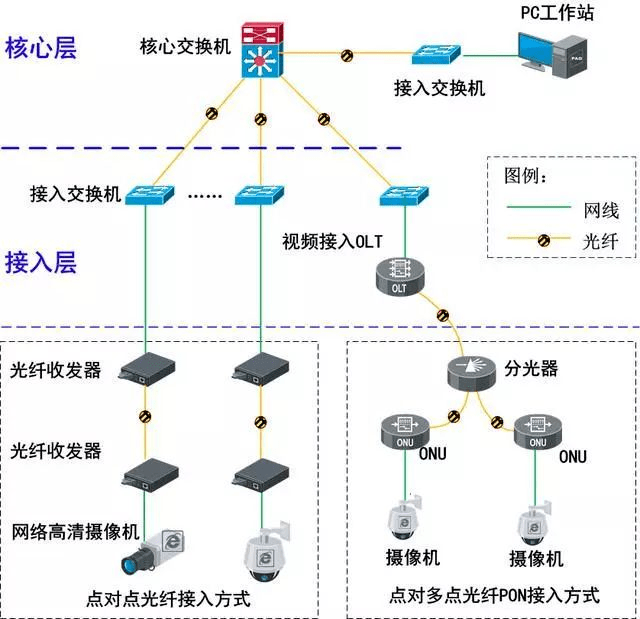
Schematic diagram of network topology
1)core layer
Ø Data center core network
The main equipment at the core layer is the core switch. As the brain of the entire network, the core switch has high configuration performance. At present, core switches generally have dual power supplies and dual engines, so core switches generally do not adopt dual-core switch deployment methods, but they have higher requirements on the backplane bandwidth and processing capabilities of the core switches.
2)access layer
Front-end video resource access
The front-end network adopts independent IP address network segments to complete the interconnection of multiple front-end monitoring devices. Front-end video resources are connected to the monitoring center or data room through an IP transmission network for aggregation. Front-end network access currently adopts two commonly used methods, usually point-to-point optical fiber access and point-to-multipoint PON access. The access layer needs to provide support for network access of NVR storage devices to ensure the security and reliability of the network environment of NVR storage devices.
user access
For the user access switch part, corresponding user access switches need to be added to provide user Internet access services. The monitoring center deploys access switches and connects them to the transmission network through 10 Gigabit/Gigabit optical fiber links. Ensure the normal application of monitoring center decoders and clients.
The two-level architecture in the network design is shown in the following figure, and the specific design will not be described in detail here.
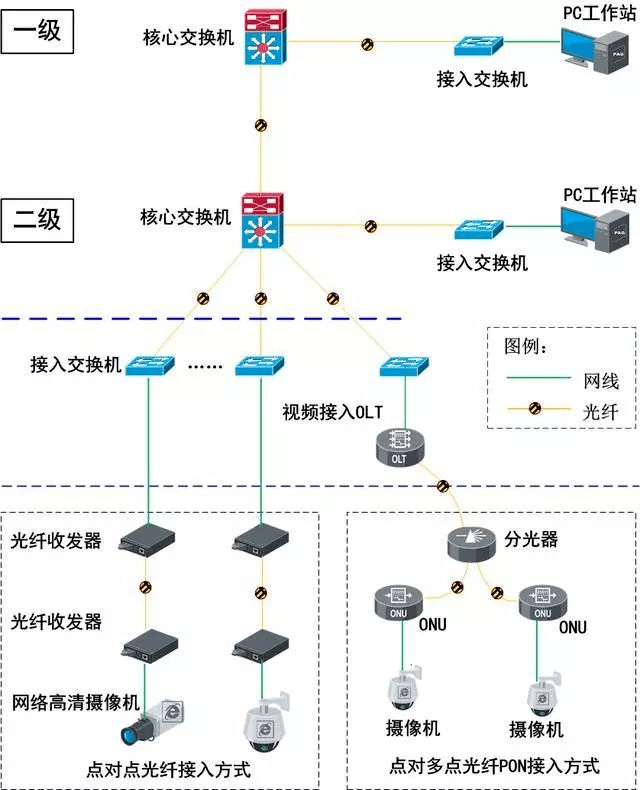
Secondary network structure design diagram
Network transmission bandwidth requirements
Taking into account the overhead of the network transmission process and other applications, the theoretical value of the available bandwidth of the link is about 80% of the link bandwidth. In order to ensure high-quality transmission of video images, it is recommended to adopt a light load design when using bandwidth, and the upper limit of the light load bandwidth is controlled within 50% of the link bandwidth.
3)The network from the core layer switch to the access switch uses optical modules for transmission, and the bandwidth needs to reach more than gigabit;
4)The bandwidth between transmission equipment such as optical fiber transceivers and access switches is recommended to reach 100 megabytes;
5)The transmission bandwidth between transmission equipment such as optical fiber transceivers is recommended to reach 100 megabytes;
networking scheme
The video surveillance project uses a 10G backbone ring network and a 10G aggregated access method to form a three-level image dedicated network system, and builds digital video surveillance points through distributed video access and storage methods.
The front end uses a high-definition network camera for digital video collection, and transmits video to the branch control center through a PON optical fiber link for unified access.
As a three-level node of the network, the branch control center is responsible for connecting all front-end videos to the digital video private network. An integrated network video storage system integrating a video monitoring system and a storage system is deployed in the branch control center to access, store and forward digital video, and store images for 30 days.
As the core node of the network, the control center is responsible for real-time video calls for the entire network and real-time monitoring of key monitoring points. As the core management node of video services, it deploys a video management platform to provide centralized and unified authorization, maintenance and management of equipment and users across the network.
The topology diagram is as follows: (PON)
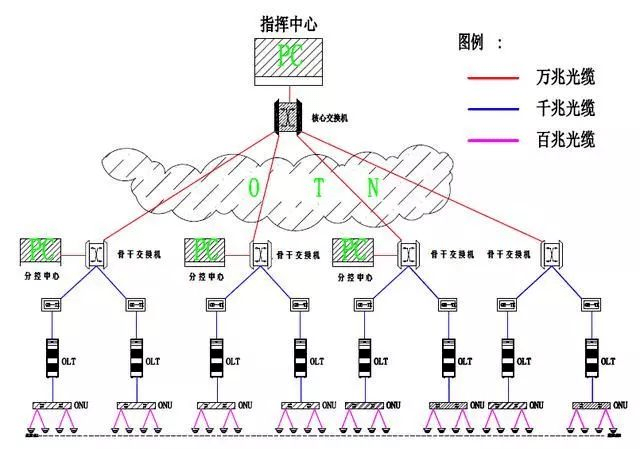
03
What are the benefits of passive optical networks for monitoring systems
1. Network planning of PON equipment-deployment of OLT. In the early stage of xPON construction, centralized setting should be adopted, and OLT nodes should be set up at transmission aggregation nodes to cover scattered users in a certain area. During the mature period of xPON application, it is advisable to adopt the principle of decentralized settings, set up OLT in wired access or wireless access point computer rooms with better conditions, and gradually transition to unified access network access and wireless access points to fully realize the comprehensive utilization of basic resources. Adopt large-capacity OLT equipment to make full use of the distance advantage of optical access, reduce offices and reduce maintenance costs.
2. Network planning of PON equipment-deployment of optical splitters. Light splitter splitting: Currently, PON can adopt a two-level light splitting method to ensure flexibility in deployment and full utilization of ports; when user penetration increases, the second-level light splitting is adjusted to first-level light splitting; for current access to PON networks, it is advisable to adopt one-level light splitting and try not to exceed two levels of light splitting. When the user scale is small, the light splitters should be centrally set; when the user scale is large, the light splitters can be appropriately dispersed to be as close to the user as possible. Layout position of light splitter: Light splitter can be arranged in handover boxes, community machine rooms, corridors and weak current wells according to the actual situation of the project.
3. Network planning of PON equipment-deployment of ONU. When building a PON network to achieve access network/FTTB, it is advisable to use equipment with built-in voice modules as much as possible to achieve comprehensive service access. The ONU should be set according to the application mode and service requirements of the FTTx network. For access network applications, ONUs should be set up in the user's home as much as possible and avoid installing them at the door or in the corridor. For general public users, ONUs can be set in a smart box of user terminals to provide protection, or placed on the desktop (using optical fiber information sockets). For FTTB applications, you can choose to place ONUs in different locations such as cabinets in corridors or shafts of buildings, outdoor optical handover boxes, etc. In principle, ONUs adopt local power supply and try not to use remote power supply. In order to ensure the normal development of voice services during power outage, backup power can be provided based on the battery module provided.
4. Network planning of PON equipment-network management. Centrally build factory network management and open northbound interfaces to facilitate access to comprehensive transmission network management.













